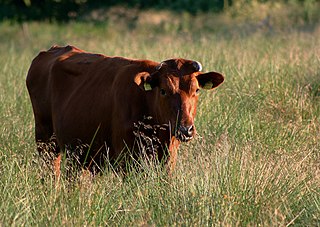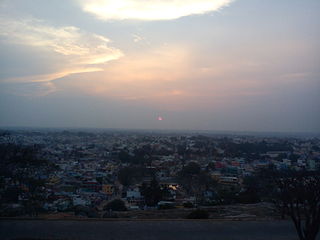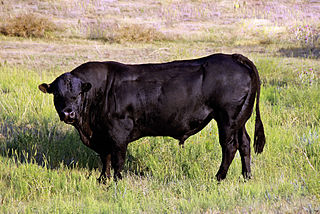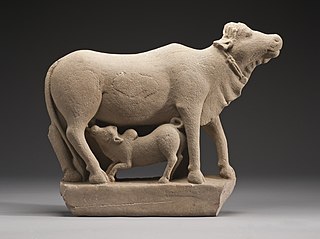
The Aberdeen Angus, sometimes simply Angus, is a Scottish breed of small beef cattle. It derives from cattle native to the counties of Aberdeen, Banff, Kincardine and Angus in north-eastern Scotland. In 2018 the breed accounted for over 17% of the beef production in the United Kingdom.

The Holstein Friesian is an international breed or group of breeds of dairy cattle. It originated in the Dutch provinces of North Holland and Friesland and in Schleswig-Holstein in northern Germany. It is the dominant breed in industrial dairy farming worldwide, and is found in more than 160 countries. It is known by many names, among them Holstein, Friesian and Black and White.

The Charolais or Charolaise is a French breed of taurine beef cattle. It originates in, and is named for, the Charolais area surrounding Charolles, in the Saône-et-Loire department, in the Bourgogne-Franche-Comté region of eastern France.

The Brahman is an American breed of zebuine-taurine hybrid beef cattle. It was bred in the United States from 1885 from cattle originating in India, imported at various times from the United Kingdom, from India and from Brazil. These were mainly Gir, Guzerá and Nelore stock, with some Indu-Brasil, Krishna Valley and Ongole. The Brahman has a high tolerance of heat, sunlight and humidity, and good resistance to parasites. It has been exported to many countries, particularly in the tropics; in Australia it is the most numerous breed of cattle. It has been used in the creation of numerous taurine-indicine hybrids, some of which – such as the Brangus and Brahmousin – are established as separate breeds.

The Galloway is a Scottish breed of beef cattle, named after the Galloway region of Scotland, where it originated during the seventeenth century.

Dairy cattle are cattle bred for the ability to produce large quantities of milk, from which dairy products are made. Dairy cattle generally are of the species Bos taurus.

Danish Red cattle, also known as Red Danish or Red Dane, are a major dairy cattle breed in northern Europe. There are 42,599 pedigree cows in Denmark. They can be used as a beef breed once they finish their useful lifetime.
Red Sindhi cattle are the most popular of all Zebu dairy breeds. The breed originated in the Sindh province of Pakistan, they are widely kept for milk production across Pakistan, India, Bangladesh, Sri Lanka, and other countries. Their milk production is about 12 to 15 kg per day. They have been used for crossbreeding with temperate (European) origin dairy breeds in many countries to combine their tropical adaptations with the higher milk production found in temperate regions. It has been crossed with Jerseys in many places, including India, the United States, Australia, Sri Lanka, etc.

Hosur is an industrial city located in Krishnagiri district in the Tamil Nadu state of India. Hosur is one of the 21 municipal corporations in Tamil Nadu. It is located on the bank of the river River Ponnaiyar, 40 kilometres (25 mi) southeast of Bengaluru and 306 kilometres (190 mi) west of Chennai, the state capital. Hosur is home to major manufacturing industries including Stellantis, Ashok Leyland, Titan, TVS Motors, Caterpillar, Ather Energy, Schaeffler, and many others.
In Sri Lanka many farmers depend on animal husbandry for their livelihood, but not a large proportion. Therefore, many livestock products have to be imported. The main livestock products in Sri Lanka are milk, meat and eggs. Hides, wools and other products are still not produced within the country. Animal power formerly used in the cultivation of rice and vegetables have been replaced by modern technology to farmlands. However animal husbandry plays an important role in the rural economy for improving the living conditions of farmers in the country.

Cattle are large, domesticated, bovid ungulates. They are prominent modern members of the subfamily Bovinae and the most widespread species of the genus Bos. Mature female cattle are referred to as cows and mature male cattle are referred to as bulls. Colloquially, young female cattle (heifers), young male cattle (bullocks), and castrated male cattle (steers) are also referred to as "cows".

A bull is an intact adult male of the species Bos taurus (cattle). More muscular and aggressive than the females of the same species, bulls have long been an important symbol in many religions, including for sacrifices. These animals play a significant role in beef ranching, dairy farming, and a variety of sporting and cultural activities, including bullfighting and bull riding.

The Kangayam or Kangeyam is an Indian breed of draught cattle from the state of Tamil Nadu, in South India. Its area of origin is Kongu Nadu, the region surrounding Coimbatore, close to the border between Tamil Nadu and Kerala, but it is distributed over a considerably wider area. The breed name derives from that of the town of Kangeyam. It may also be called Kanganad or Kongu.

Ongole cattle are an indigenous cattle breed that originates from Prakasam District in the state of Andhra Pradesh in India. The breed derives its name from the place the breed originates from, Ongole. The Ongole breed of cattle, Bos indicus, is in great demand as it is said to possess resistance to both foot and mouth disease and mad cow disease. These cattle are commonly used in bull fights in Mexico and some parts of East Africa due to their strength and aggressiveness. They also participate in traditional bull fights in Andhra Pradesh and Tamil Nadu. Cattle breeders use the fighting ability of the bulls to choose the right stock for breeding in terms of purity and strength. The mascot of the 2002 National Games of India was Veera, an Ongole Bull.

Cattle slaughter in India, especially cow slaughter, is controversial because of cattle's status as endeared and respected living beings to adherents of Dharmic religions like Hinduism, Jainism, Buddhism and Sikhism; while being an acceptable source of meat for Muslims, Christians and Jews. Cow slaughter has been shunned for a number of reasons, specifically because of the cow's association with the god Krishna in Hinduism, and because cattle have been an integral part of rural livelihoods as an economic necessity. Cattle slaughter has also been opposed by various Indian religions because of the ethical principle of Ahimsa (non-violence) and the belief in the unity of all life. Legislation against cattle slaughter is in place throughout most states and territories of India.

North American Piedmontese cattle are a breed of domestic beef cattle originating from an imported herd of select Italian purebred Piedmontese cattle. The foundation line of breeding stock was first imported from Italy into Canada in 1979, and into the United States in the early 1980s. Piedmontese cattle are distinguished by a unique, naturally occurring gene identified as the myostatin allele mutation, or inactive myostatin gene. Myostatin prohibits muscle growth whereas an inactive gene has the opposite effect. Purebred Piedmontese are homozygous,, which means they have two identical alleles present for this unique gene. Research indicates the presence of the myostatin allele mutation produces morphological characteristics unique to the breed, such as double-muscling, beef tenderness, reduced fat content and high yield. According to the North American Piedmontese Association (NAPA), they are the first breed registry to base animal registration requirements on the presence of this specific gene which can be easily verified by DNA testing.

The 2017 pro-jallikattu protests, also known as the pro-jallikattu movement, were leaderless apolitical youth protests which took place in January 2017 in large groups in several locations across the Indian state of Tamil Nadu. Some sporadic smaller protests also took place across India as well as overseas. The chief motivation of the protest was against the Supreme Court's order to ban jallikattu, a traditional Tamil bull taming sport, which is held during Pongal, a harvest festival in the state of Tamil Nadu, India. The sport is conducted annually on the second day of the Tamil month Thai. The sport was banned by the Supreme Court in a decision citing cruelty to animals based on a lawsuit filed by the animal rights group People for the Ethical Treatment of Animals (PETA), which asserted that it violates the Prevention of Cruelty to Animals Act (PCA).

P. Balakrishna Reddy is a politician and former Minister of Tamil Nadu. He was elected as a MLA from Hosur in 2016. He started his political career from Bharatiya Janata Party. He had also served as the chairman of the Hosur municipality. He became Animal Husbandry Minister and later Youth Welfare and Sports Development Minister in Tamil Nadu.

Dairy plays a significant part in numerous aspects of Indian society, including cuisine, religion, culture, and the economy.
The Department of Animal husbandry and Dairying (DAHD) is an Indian government department. It is a subsidiary department of the Ministry of Animal Husbandry, Dairying and Fisheries which was formed as a new Indian ministry in 2019. The DAHD or the erstwhile Department of Animal husbandry, Fishiries and Dairying was formed in 1991 by merging together into a separate department, of two divisions of Department of Agriculture and Cooperation, namely animal husbandry and dairy development.In 1997 the fishiries division of Department of Agriculture and Cooperation and a part of the Ministry of Food Processing Industries was transferred to it. In February 2019 the Department of Fisheries was carved out from the Department of Animal husbandry, Dairying and Fisheries and it has been functioning as Department of Animal Husbandry and Dairying since then.


















